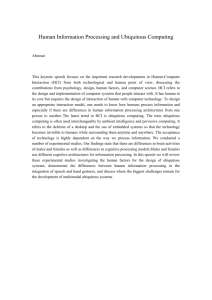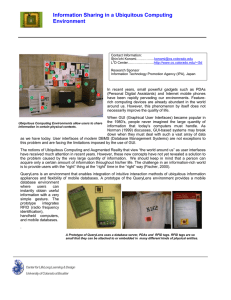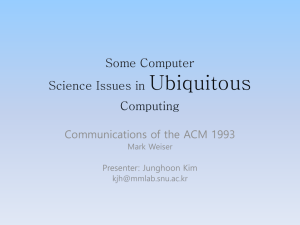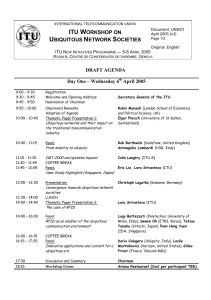Ubiquitous Network Societies: Highlights from the Japan country case study Lara Srivastava
advertisement
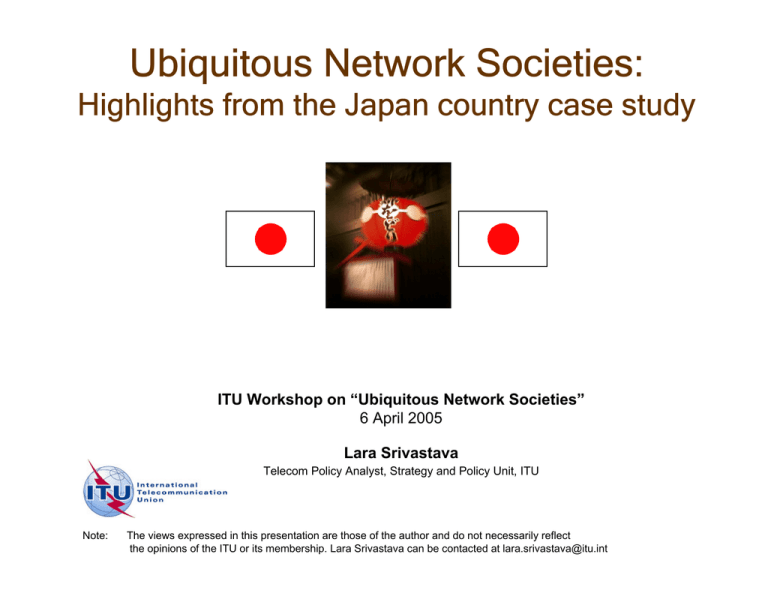
Ubiquitous Network Societies: Highlights from the Japan country case study ITU Workshop on “Ubiquitous Network Societies” 6 April 2005 Lara Srivastava Telecom Policy Analyst, Strategy and Policy Unit, ITU Note: The views expressed in this presentation are those of the author and do not necessarily reflect the opinions of the ITU or its membership. Lara Srivastava can be contacted at lara.srivastava@itu.int International Telecommunication Union Why Japan? • Tech-savvy population – Popularity of consumer electronics on the whole, and particularly the mobile phone • Mobile phones as ubiquitous & indispensable fashion statements • One of the first countries to launch IMT2000/3G • Nation with cheapest broadband access in the world (Source: ITU) • Government implementing a number of strategy initiatives geared specifically towards the further development of a “ubiquitous network society” 2 International Telecommunication Union J ap an 8 9 .5 % 8 7 .0 % Japan as a leader in mobility K o re a (R e p .) 3 3 .0 % A rg e ntina C hina 3 0 .9 % 2 5 .3 % S ing ap o re 2 4 .4 % T aiw an 2 2 .4 % Italy 2 1 .7 % C anad a 2 0 .2 % A us tria 1 9 .3 % N e the rland s 1 7 .9 % F inland A us tralia 3 1 4 .8 % G e rm any 1 3 .8 % S w itze rland 1 3 .2 % F ranc e 1 2 .5 % U nite d S tate s 1 2 .1 % Ne w Z e aland 1 2 .0 % F ranc e 1 1 .7 % P o rtug al 1 1 .1 % Mobile Internet Subscribers as % of Mobile Subscribers Subscribers to Fixed and Mobile Services, 1996-2003 (millions) 100 90 80 Source: MIC, 3G Mobile 70 60 50 U nite d K ing d o m 9 .3 % 40 U nite d S tate s 8 .9 % 30 H o ng K o ng 8 .7 % 20 G e rm any 8 .5 % 10 S p ain 8 .3 % 0 B e lg ium 1 .2 % Source: ITU D e nm ark MIC 1 .1 % 1996 1997 1998 1999 2000 2001 2002 2003 Fixed 62.64 62.85 62.63 62.23 61.96 61.33 60.77 60.22 Mobile 26.91 38.26 47.31 56.85 66.78 74.82 81.12 86.65 International Telecommunication Union 3G or IMT-2000 “Keitai” Japan's 3G/IMT-2000 subscribers by technology (m illions) 25.67 22.65 W-CDMA 19.48 CDMA 2000 1x 15.48 13.79 11.09 4.82 2.79 1.27 0.14 0.03 4 Dec01 0.09 Mar02 0.12 2.65 1.15 Jun02 Sep02 4.78 3.18 1.09 0.53 14.7 0.36 0.15 Source: MIC 6.81 6.75 1.99 8.93 7.17 8.87 8.4 10 11.8 12.3 Dec03 Mar04 15.9 16.8 Sep04 Dec04 4.67 Dec02 Mar03 Jun03 Sep03 Jun04 International Telecommunication Union Content accessed through near–ubiquitous mobiles vs. PCs Types of Content Accessed from Cell Phones (2003) Mobile Content (2003) Ring tones 43.4% Wallpapers 21.9% Music 20.2% Video games 13.9% News/weather Visuals Paid email newsletters Software 7.3% 3.8% 2.4% Online Books 0.4% Other 5 Source: MIC 4.3% 84.0% Types of Internet Content Accessed from PCs (2003) PC Content (2003) 28.0% Softw are Music 21.3% Visuals 19.7% Video Games New s/Forecasts 12.4% 10.0% Screensavers 7.0% Ring tones 6.7% Paid email new sletters 5.3% Online Books 4.3% Other 4.0% International Telecommunication Union The path to ubiquitous networks: An increase in the scale of network connections over time 6 Source: Murakami, ITU-T NGN Forum, July 2003 International Telecommunication Union Highlights: Chips and Codes • RFID – In Roppongi Hills trial – read or shop? – Sushi à la RFID – RFID tracking and transport – Mobile digital wallets • The DoCoMo 2D Code 7 – With this, mobile can read data from a simple code – Eventually hyperlinks will be included – A first step to the T-Engine Forum’s “Ubiquitous Communicator”? International Telecommunication Union Japan’s strategy for ubiquitous communications • Japan is aiming for a “ubiquitous network society”, that is to say a society in which there is “anytime, anywhere” access, for “anyone and anything” • Since 2003, MIC has been working closely with industry and academia to stimulate the development of ubiquitous networks • Current focus on three key technology areas: 8 1. Microchip network technology 2. Ubiquitous network identification and agent technology 3. Ubiquitous network control and management technology International Telecommunication Union A 3-fold R&D approach towards ubiquity of communications Microchip Microchip network network technology technology Through high-functionality microchips, a variety objects can be freely connected to the network. Microchips Books Documents Welfare, elderly, care Ubiquitous Ubiquitous network network authentication authentication and and agent agent technology technology Through simply holding a contact-less card, any terminal can be instantly configured as your own. ey e-mon d r IC ca Regardless of the terminal type, anything and anywhere can be configured as your own terminal. Ubiquitous Ubiquitous network network control control and and management management technology technology Wherever you are and whenever you like, you can enjoy the same communication services and diversity of content as in the office. office Variety of largevolume information Identification information Chips attached to various objects Clothes Parcels To own settings Brand goods Securities, stamps and vouchers Identification Ubiquitous Network Server Ubiquitous network to which it is possible to unconsciously connect anywhere, anytime and with anything. It is essential to develop complex management technology. Able to get the same information as in the office wherever you are Please configure Variety of large- Control connectivity of 10 billion chips 9 scale information Confirmed identity! Send configuration information Source: MIC International Telecommunication Union But ubiquity also means access for all segments of the population • Great demand for simple mobile handset for those not wishing/needing to use Internet or cameras • TU-KA, KDDI’s 2G arm, released this simple handset (Tu-Ka S) in Nov 2004. • Tu-Ka S has no LCD display or users manual, and has been a smash hit for users over 60! 10 International Telecommunication Union User concerns relating to ubiquitous communications… User concerns relating to their use of ubiquitous network services (2003) 62.7% Fraud and unscrupulous methods of business Leaks and improper use of personal information in the possession of businesses 59.7% Improper access to and use of personal information 58.2% 49.2% Increasing complexity of services and devices Infection by computer viruses etc… 37.8% Possibility of being monitored by 3rd parties including family 37.5% 35.7% Excessive reliance on ICT devices 34.7% Decline in thinking abilities and reading/writing skills 24.7% Weakening of personal relationships None in particular Other No reponse 11 7.7% 2.3% 1.2% Source: MIC International Telecommunication Union … addressed by Japan’s Charter for “Ubiquitous Network Society” Establish a charter summarizing the basic principles and shared understandings for the ubiquitous network society Ubiquitous Network Society Charter (Draft) Preamble Latent potential of ICT and its role in future society Ubiquitous network society — definitions, objectives and significance Balance between free and diverse information distribution, and safe and secure information distribution Positioning of the Charter Free and diverse information distribution Safe and secure information distribution Privacy Information access & dissemination rights Information security Information diversity Promotion of information technology in business and society Balance Intellectual property rights Information literacy Information ethics Support Construction of new social infrastructure Systems for local and international coordination and cooperation Balance between the real society and the cyber society 12 thank you “domo arigatoh gozaimasu” lara.srivastava@itu.int

